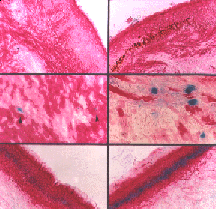

High resolution image (4.9 MB eps-format)
BERKELEY -- Researchers have developed the first technique for identifying those cells within living organisms that have reached old age.
Senescent cells, as they are called, no longer are capable of dividing yet remain metabolically active. Furthermore, they exhibit changes in form and function such as are evident between the supple skin of a child and the wrinkled skin of the elderly.
Scientists know senescence is an irreversible stage in the life of the cell yet they are intent upon learning much more about this vital process. Senescence not only may be an underlying cause of aging but also a means for preventing the uncontrolled growth of cells -- what we know as cancer.

In an article being published September 26 in the Proceedings of the National Academy of Sciences, a team of biologists describes a simple, rapid, and inexpensive test for identifying senescent cells. The test, developed by Ernest Orlando Lawrence Berkeley National Laboratory life scientists Judy Campisi, Goberdhan Dimri, and colleagues at several other research institutions gives science a powerful new tool for examining senescence.
Campisi says that because it had not been possible to detect or study senescent cells in a living animal (in vivo ), the research until now has focused on cells grown in culture. Campisi notes that the new technique has provided the first actual evidence that senescent cells may exist in living organisms, and that they accumulate with age.
The ability to distinguish senescent cells in vivo should allow researchers to take a much closer look at their suspected role in tumor suppression and aging.
"One could say that senescence is the opposite of cancer," says Campisi. "Some of the same genes that drive uncontrolled proliferation in cancer seem to be under tight control, or actually turned off, in senescence."
Currently, many researchers are searching for genes with anti-proliferative or tumor-suppressive properties. Some are involved in basic science -- the quests to understand the processes of aging and cancer. Others are attempting to develop drugs and diagnostic procedures.
The new technique should allow scientists to screen compounds for senescence-inducing or senescence-delaying activity. These compounds may have anti-tumor or anti-aging properties.
The method also can be used to identify genes able to stop cancerous cells from replicating. Likewise, it should help in the isolation of genes that trigger premature aging syndromes.
Campisi said the technique emerged after researchers discovered that senescent cells produce or express an unusual form of a particular enzyme. This enzyme, beta-galactosidase, either is absent or virtually absent in its senescence-associated form in presenescent cells.
Based on this finding, a simple assay was developed that uses a stain to detect the presence of the enzyme. Old cells -- those that express the senescence-associated beta-galactosidase -- turn blue.
Why senescent cells produce the enzyme is unknown. Campisi says it is unlikely that this activity is responsible for shutting down the ability of a cell to proliferate. Instead, she said, the enzyme probably is a consequence of senescence and most likely associated with the change in cell function that invariably accompanies senescence.
Researchers report that the senescence-associated beta-galactosidase is expressed by a variety of senescent human cells but that it is not a universal biomarker for senescence in every cell type. Among those cells for which it does mark senescence are two major skin cell types, fibroblasts and keratinocytes.
Says Campisi, "In vivo studies show that young skin has thick dermis with organized collagen fibers. Old dermis is thin with less collagen and less organized collagen fibers. Senescent fibroblasts in culture are well known to produce large amounts of collagenase, the enzyme that degrades collagen. Thus, senescent cells not only stop dividing, but change function. And, examining skin from human donors of various ages, we now have shown that the frequency of fibroblasts and keratinocytes expressing the senescence-associated beta-galactosidase increases markedly with age. This suggests that the thinning of the skin that occurs with age may be due to the accumulation of senescent, collagenase-producing fibroblasts." The in vivo studies were done in collaboration with Monica Peacocke at the New England Medical Center.
Campisi said it would be foolish to attempt to completely reverse senescence in cells because this cessation of growth also prevents cancer. On the other hand, the ability to manage or alter the changes in form and function that are synonymous with senescence -- what is known as the senescent phenotype -- has obvious value.
The biotech industry one day may attempt to change the phenotype of senescent cells, for instance as a route to deal with the skin problems experienced by older people. Again, the new assay should prove helpful, serving as a first line test to discover new drugs and monitor their effects in vivo.
The Berkeley National Laboratory conducts unclassified scientific research for the U.S. Department of Energy. It is located in Berkeley, California and is managed by the University of California.